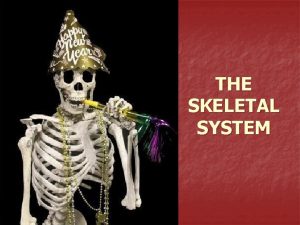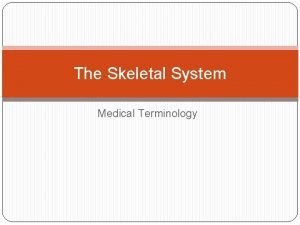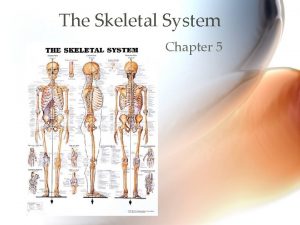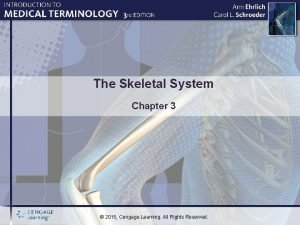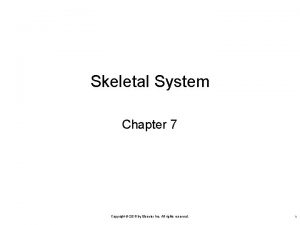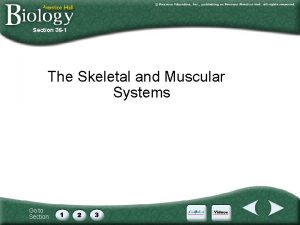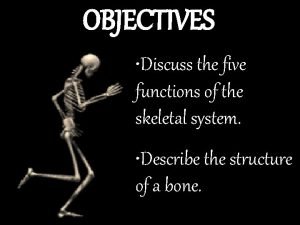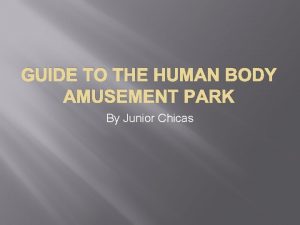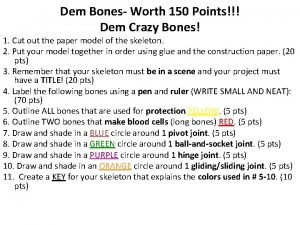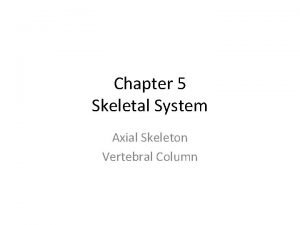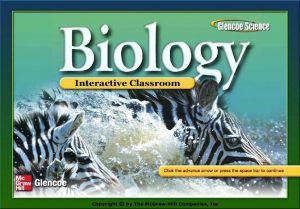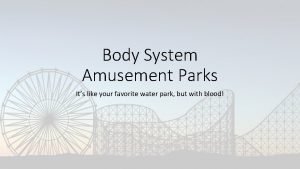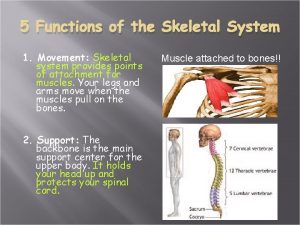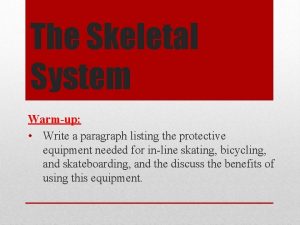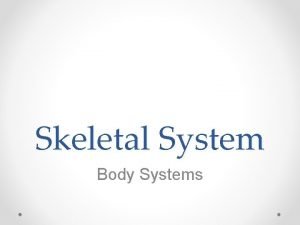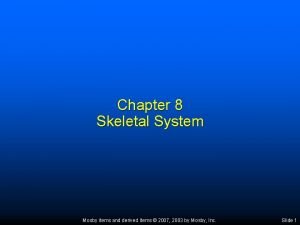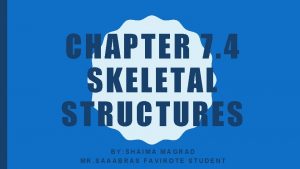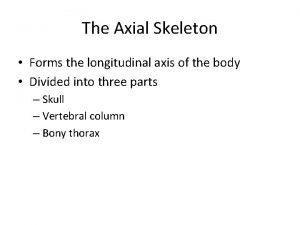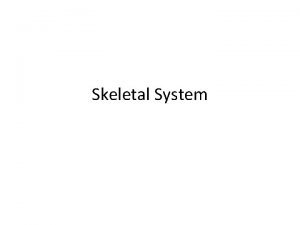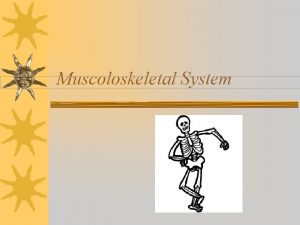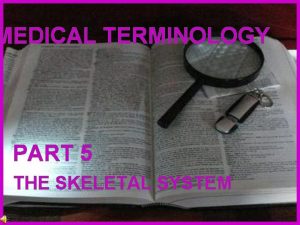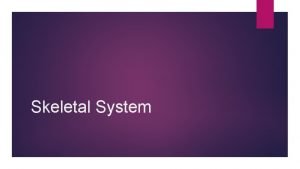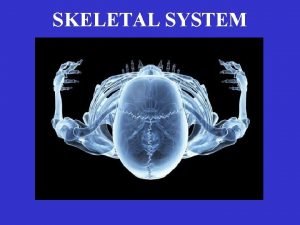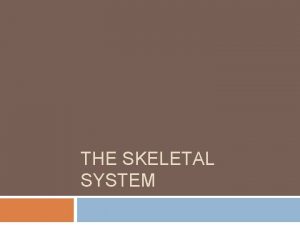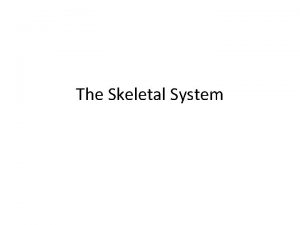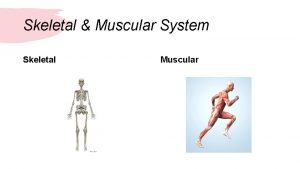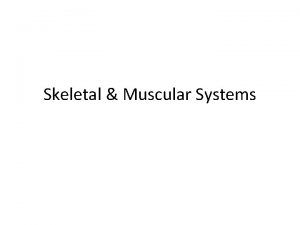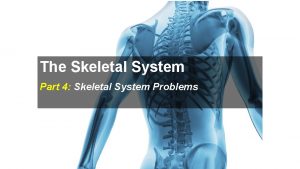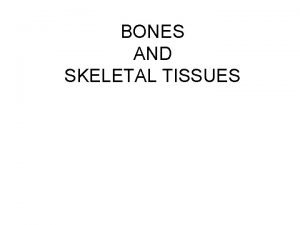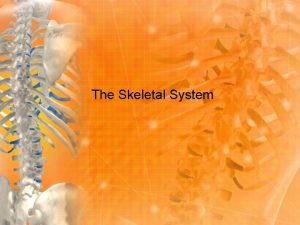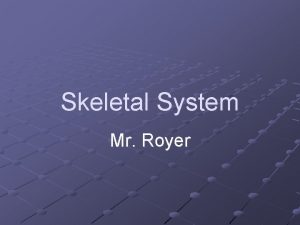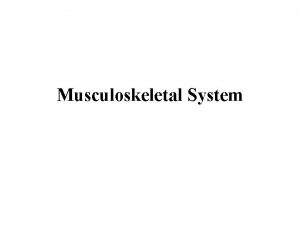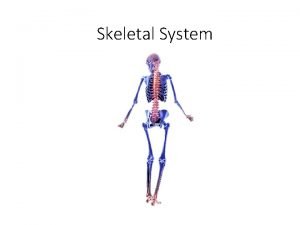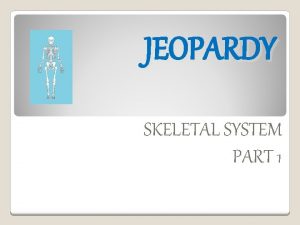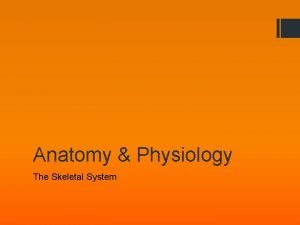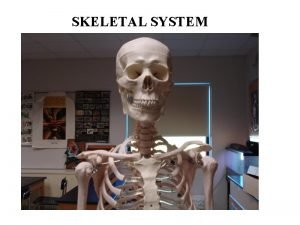The Skeletal System Part 1 The Skeletal System


































- Slides: 34

The Skeletal System Part 1: The Skeletal System

Five Functions The skeletal system has 5 main functions. 1. Provides shape and support 2. Enables movement 3. Protection of internal organs 4. Produces blood cells 5. Storage of minerals (Ca, P)

Skeletal and Muscular Systems The skeletal & muscular systems interact. 1. Work together to allow body movement 2. Bone attaches to bone via ligaments 3. Muscle attaches to bone via tendons 4. Movement �� muscles pulling bones at joints 5. Skeleton = structure; muscles = mobility

The Skeleton Made of 206 bones total. Divided into 2 parts: AXIAL SKELETON • • • 80 bones Makes up the central axis of the body Includes: skull, ribs, spine, sternum, vertebrae, hyoid (jaw) APPENDICULAR SKELETON • • • 126 bones Makes up the limbs hanging off the axial Includes: upper and lower extremities, pelvic girdle, phalanges

The Skeleton AXIAL SKELETON APPENDICULAR SKELETON

Three Parts The skeletal system is made of 3 parts: Bones Strong living tissue – 206 in total Cartilage Tissue more flexible than bone Ligaments Tissue that holds bones in place

5 Types of Bones come in many shapes and sizes, yet bones of the body fall into 5 categories: 1. long bones 2. short bones 3. Flat bones 4. Irregular bones 5. Sesamoid bones the

Types of Bone

1. Long Bones 1. Long bones • Longer than wide • Work as levers • Have a shaft and two ends • Provide strength, structure and movement • E. g: bones of the arms & legs

2. Short Bones 2. Short bones • Short • Cube-shaped • E. g: ankle and wrist bones

3. Flat Bones 3. Flat bones • Thin, flat, with a broad surface, often curved • Used to protect organs and to attach wide muscles • E. g: sternum, scapula, ribs, skull

4. Irregular Bones 4. Irregular bones • Odd-shaped; don’t fit into other categories • Variety of shapes and sizes • E. g: hip bones, vertebrae, middle ear bones

5 Types of Bone 5. Sesamoid Bones • Short bones that are found within tendons • E. g. patella (knee cap)

Bone Structure Bones are complex living structures. Bone is one of the strongest tissues in the human body – and one of the lightest! Bones are made of 5 materials: Periosteum Compact bone Spongy bone Bone marrow Cartilage

Long Bone Anatomy artilage

Periosteum • Outer surface of bone surrounded by this double membrane • Covers ALL bone surfaces, except joint surfaces (cartilage) • Outer fibrous layer made of dense connective tissue • Inner osteogenic (“bone making”) layer composed of 2 cells: osteoblasts and osteoclasts • Supplies blood vessels & nerves to the bone

Compact Bone • Accounts for 80% of bone mass • Hard outer layer of bones, but not totally solid! • Provides strength and protection • Give bones their smooth, white, and solid appearance • Made up of repeated individual tube-like units called osteons*

Spongy Bone • Has many air pockets; create a light yet very strong structure • Accounts for 20% of bone mass • Found at the ends of long bones or center of short or flat bones • Less dense than compact bone; has many cavities which are filled with bone marrow • Make bones light and strong

Bone Marrow Bone marrow • Bone marrow is also called myeloid tissue • It is a soft, gelatinous tissue that fills bone cavities • It is either RED or YELLOW, depending on how much hemapoeitic (red) or fatty (yellow) tissue is present

Special Topic: Bone Marrow RED BONE MARROW • Produces red blood cells, white blood cells and platelets in a process called hemopoiesis • Helps the body with every day functions by producing RBCs • In children, nearly every bone is filled with red marrow • Found in the flat bones of the skull, vertebrae, sternum, ribs, shoulder blades and pelvis YELLOW BONE MARROW • Produces fat cells • Helps the body survive extreme cases of hunger or blood loss by serving as an energy reserve • With age, half of the red bone marrow is gradually replaced with yellow marrow • Found in the hollow interior of long bones such as the arms and legs

Red and Yellow Bone Marrow

Cartilage • • • Tough, flexible and slippery type of connective tissue Mostly water: no blood vessels or nerves Found at end of bones where they meet other bones Reduces friction and acts as a shock absorber Also in growth plates in children Heals poorly and slowly

3 Types of Cartilage hyaline cartilage • Most abundant type • Fine collagen matrix • Found in cartilage in movable joints, rib joints, respiratory tract and nasal passages elastic cartilage fibrocartilage • Similar to hyaline, but with more elastic fibers • Rows of chondrocytes with thick collagen fibers • More flexible • Highly compressible with high e strength • Found in external ear pinnae and epiglottis • Found in knee menisci, intervertebral discs, pubic symphysis


4 Bone Cells Bones are made of 4 kinds of cells: osteoblast osteocyte Create new bone Star-shaped; for growth or repair. maintains existing Make a flexible bone; long arms material called allow them to osteoid 1 st, then exchange minerals add minerals to and communicate harden it. Will with nearby become lining cells osteocytes or osteocytes lining cell osteoclast Very flat cells that cover entire surface of bone; control movement of material in/out of bone; made from osteoblasts that have stopped making new bone Breakdown and reabsorb old bone; large cells with many nuclei. Reshape bone to: repair breaks, open new passages, strengthen bone.

Osteon / Haversian System • If you looked at compact bone through a microscope, you would see it’s not solid at all. • Compact bone is filled with many tiny passages, or canals, for nerves and blood vessels. • Compact bone is made of special cells called osteocytes. • These cells are lined up in rings around these canals.

Osteons • Together, a canal and the osteocytes around it make up a single tube-like unit of bone called an osteon. • Osteons are like thick tubes all going the same direction inside the bone, similar to a bundle of straws with blood vessels and nerves protected in the center.

Osteon / Haversian System

Bone Growth • Bone growth begins in the growing embryo. • By end of 8 th week after conception, the skeletal pattern in created in cartilage • Ossification (bone development) begins over this cartilage base and replaces it • Long bones then develop locations for new growth at either end of the bone shaft • Between the developing bone and ossified bone is a layer of cartilage called a growth plate, which is also called the epiphyseal plate • This growth plate moves steadily away from the bone towards the ends until all the cartilage is ossified, usually in the early 20 s

Epiphyseal (Growth) Plate

Bone Growth

Bone Remodelling Steps 1. Resorption: old bone is broken down and reabsorbed by osteoclasts. This takes approx. 10 days. 1. Reversal: Immune system macrophages arrive at the remodeling site to create an intermediate step 1. Formation: osteoblasts precursors arrive, divide and grow into mature osteoblasts, secrete new bone matrix. 1. Mineralization: Bone matrix mineralizes to create new, strong bone. 1. Resting/Quinessence: Bone enters a resting stage and is maintained by inner osteocytes and protective lining cells

Bone Remodelling Steps

Any Questions?
 Part part whole addition
Part part whole addition Part to part ratio definition
Part to part ratio definition Part part whole
Part part whole Define technical description
Define technical description Different parts of a bar
Different parts of a bar The phase of the moon you see depends on ______.
The phase of the moon you see depends on ______. Two way anova minitab 17
Two way anova minitab 17 What are the five functions of the skeletal system
What are the five functions of the skeletal system Medical terminology skeletal system
Medical terminology skeletal system Skeletal system
Skeletal system Chapter 3 skeletal system kaplan answer key
Chapter 3 skeletal system kaplan answer key Chapter 7:4 skeletal system
Chapter 7:4 skeletal system Chapter 5 the skeletal system
Chapter 5 the skeletal system Section 36-1 the skeletal system
Section 36-1 the skeletal system What are the five functions of the skeletal system?
What are the five functions of the skeletal system? Body system amusement park
Body system amusement park Dem crazy bones answer key
Dem crazy bones answer key Chapter 6 skeletal system
Chapter 6 skeletal system Chapter 5 the skeletal system vertebral column
Chapter 5 the skeletal system vertebral column Chapter 32 section 2 the skeletal system answer key
Chapter 32 section 2 the skeletal system answer key Body amusement park
Body amusement park What is the 5 functions of the skeletal system
What is the 5 functions of the skeletal system Navigating the body regions of the body
Navigating the body regions of the body Skeletal system paragraph
Skeletal system paragraph Coccyx meaning
Coccyx meaning Whats the main function of the skeletal system
Whats the main function of the skeletal system Chapter 8 skeletal system
Chapter 8 skeletal system Chapter 7 4 skeletal system
Chapter 7 4 skeletal system Body sutures
Body sutures Skeleton
Skeleton The axial skeleton forms the longitudinal axis of the body
The axial skeleton forms the longitudinal axis of the body Skeletal system bell ringer
Skeletal system bell ringer Axial skeleton vs appendicular
Axial skeleton vs appendicular Muscolo skeletal system
Muscolo skeletal system Constructed versus nonconstructed terms
Constructed versus nonconstructed terms







